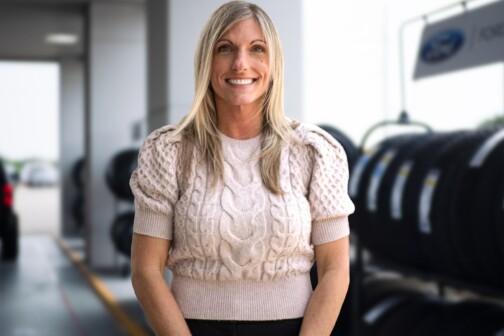Faye Dunaway, forced to choose between a camping trip with Paul Newman or the managing editorship she has worked years to get, heads for the woods with Newman after he rescues a skyscraper full of people, including several hundred apparently helpless women who do little more than scream and fall out of windows. Al Pacino slams a door on Diane Keaton, who has tried to assert her individuality in the face of Sicilian machismo. Julie Andrews becomes a sexual pawn (Julie Andrews?) in a Cold War game between the British and the Russians, and finally gives up her top-security job to join Omar Sharif in exile.
So much for women in recent movies. Hollywood features used to be full of strong, intelligent and resourceful women like Rosalind Russell in His Girl Friday (1940), or Katharine Hepburn in Holiday (1938), or Bette Davis in almost all of her films of the Thirties and Forties. But now, in the liberated Seventies, when we’re all supposed to have had our consciousnesses raised about sexual stereotypes and women’s roles in real life, along come The Towering Inferno, Godfather II, and The Tamarind Seed to introduce us once again to Woman as Faithful Love-Slave, Woman as Victim, and Woman as Sex-Object (Julie Andrews?).
There is currently only one woman in the top ten box-office stars: Barbra Streisand. In most of her films, Streisand plays the kind of witty, independent and sexy woman that the older films featured, and adds her special touch by playing ugly duckling opposite gorgeous leading men. Funny Girl and The Way We Were have a probably unintentional feminist edge to them: a homely girl falls for a handsome man (Omar Sharif, Robert Redford), and finds out that not only is their beauty illusive, but that she becomes beautiful and strong through her relationship with these men – so strong, in fact, that the relationship becomes oppressive to her. But other than Streisand, there have been very few strong and independent women in recent films. The strongest women we have seen on the screen lately have been black – Diahann Carroll in Claudine and Cicely Tyson in Sounder and the made-for-TV Autobiography of Miss Jane Pittman. After years of stereotyping blacks as mammies or Stepin Fetchit types, movie-makers have had to respond to changing social attitudes and no longer dare to cast blacks in demeaning roles. Why, then, do they continue to stereotype women?
Like much else in movies, the portrayal of women depends on what movie-makers think people will pay to see. Films with strong female characters flourished in an era when movie-going was a pastime rather than part of an expensive evening on the town. “Women’s pictures” – tear-jerkers like Back Street, Mildred Pierce and Imitation of Life – were standard matinee fare for housewives, who could weep through them at the neighborhood theater. Now our crime-haunted cities scare people into traveling in packs, and your local neighborhood theater has probably become a porno house. Since in many households it takes a lot of effort on the part of the Little Woman to get the Old Man out of his Barca-lounger and away from the tube, current movies rely on reassuringly “masculine” images. So Hollywood gives us lots of macho types like Clint Eastwood and Charles Bronson, or Gene Hackman in The French Connection; and buddy-buddy teams like Newman and Redford, Newman and McQueen in The Towering Inferno, and Charlton Heston and George Kennedy in both Earthquake and Airport 1975.
This state of things makes a modest and not entirely satisfactory film like Martin Scorsese’s Alice Doesn’t Live Here Anymore look like a sign of a new trend toward three-dimensional portrayals of women in the movies. It should at least provide a breakthrough for the career of its star, Ellen Burstyn. Though she has been around for years, Burstyn has only lately come to prominence as an actress, primarily as an Oscar also-ran in The Last Picture Show and The Exorcist. Her performance in Alice Doesn’t Live Here Anymore is the film’s strong suit, though she sometimes has to fight the script to make Alice a totally integrated character. Her chief resource as an actress is her face, which, somewhat like Joanne Woodward’s, goes back and forth between plainness and beauty. At the beginning of the film, as a frustrated wife trying desperately to please a bored husband and a manic twelve-year-old son, she looks plain, even haggard. She acquires a radiance when, after her husband’s death, she sets out for her childhood home in Monterey, California, and discovers her reserves of cleverness and strength on the journey.
Alice seems too self-aware for such a flatly symbolic search for a lost paradise to become the idée fixe that the script makes it. But as far as recent films are concerned, it is remarkable that this journey is the odyssey of a woman and her son, and not two motorcycle buddies or John Wayne and an idiot female given to fainting at inconvenient moments. Like all symbolic journeys, Alice’s involves education through disillusionment. She falls for a man, played by Harvey Keitel, whose manner is as self-effacingly come-on-soft as her late husband’s was cocksure and domineering. But when his wife shows up to warn Alice away, Keitel explodes with a violence that is part masculine sexual display and part spoiled-little-boy tantrum. Twice burned, Alice is in no mood to respond when the right kind of man, played by Kris Kristofferson, appears. Unfortunately, Kristofferson’s rightness is something the film asks us to take on faith. We are supposed to recognize him as a type: the flower child of the Sixties transformed into the gentle pseudo-redneck of the Seventies. He displays a nice balance of masculine assertiveness (he’s a rancher and he takes a firm, paternal hand with Alice’s son) with feminine gentleness (he’s a musician, he has a kind face, and he’s willing to give up his ranch to take Alice to Monterey). And that’s the film’s denouement: Alice, convinced that Kristofferson is willing to accept her illusions as realities, gives up those illusions and settles down to a new married life.
No, it doesn’t work. Like other things in the movie, it seems a compromise between realism and message. Scorsese films the story in a neoreal-istic style, with unsettling hand-held camera sequences which, if they have a point, are probably meant to emphasize the instability of Alice’s world. He allows his actors to improvise scenes, but the style of the improvised scenes is at odds with Robert Getchell’s conventionally-plotted screenplay. The “experimental” style of Alice Doesn’t Live Here Anymore might have looked fresh, innovative, even revolutionary fifteen years ago, but it just looks ragged now.
Like so many recent films, this one is saved by its actors. In addition to Burstyn, Keitel, and Kristofferson, there are fine performances by Billy Green Bush as Alice’s husband, Alfred Lutter as Alice’s obstreperous pre-adolescent son, and Diane Ladd as Flo, a tough, foul-mouthed waitress – a role that could have been nothing more than a stereotype in the hands of a lesser actress than Ladd. In her scenes with Alice, Flo reveals that her hard-boiled manner is a last ditch defense against despair. This admission suggests that Alice Doesn’t Live Here Anymore isn’t about women’s liberation. It’s about sexual survival. Everyone in the film is involved in some form of sexual warfare, even Alice’s twelve-year-old son. His closest friend, played by Jodie Foster, is the androgynous pre-pubescent daughter of a hooker; she introduces him to the forbidden delights of shoplifting and getting smashed on Ripple, then taunts him with her worldly swagger after he gets drunk, disorderly, and sick. At such moments the film makes us marvel that we survive the effects of puberty as long as we do.
Alice Doesn’t Live Here Anymore is certainly not a feminist film. Alice is clearly dependent on men to help her achieve emotional stability, although she really blossoms when sex is not an issue, as in her easy give-and-take with her son, and in the camaraderie with Flo. This last relationship is one of the film’s pleasantest departures from the conventional treatment of women, who in the movies are almost never allowed a close relationship with one another that doesn’t have some overtones of perversion or bitchiness. After all, if Newman and Redford can pal around with no hint of homosexuality, why can’t two women be buddies on the screen? Unfortunately, we still sense that the lives of men like Newman and Redford can be complete without marriage, while the script for Alice seems to suggest that Alice and Flo are somehow incomplete without a good steady Kristofferson type to give meaning to their lives.
So the ending of Alice looks like acop-out from a strictly feminist pointof view. But looking at it that way is,I think, unfair to the film. For AliceDoesn’t Live Here Anymore pointsmovies in the right direction: awayfrom the treatment of women as furniture and property, as brainless love-goddesses, neurotic bitches, spinelessvictims, or tough-as-nails heart-of-gold hookers. It suggests instead thatmovies may be ready to try to do whatmany contemporary women novelists,like Margaret Drabble and MargaretAtwood, are doing: show womenchanging their lives, adapting to newand formerly forbidden roles, surviving, and enjoying themselves.
D-Rated Movies
David Brudnoy
At Long Last Love: At long last schmaltz, the dead-weighting of sixteen wonderful old Cole Porter songs, as mauled by Burt Reynolds, Cybill Shepherd, and Madeline Kahn, among the major perpetrators. A clunky “comedy” dying by the minute; love and hijinks among the well-to-do and the would-be-rich, and some lovely art deco sets to redeem it from utter worth-lessness.
A Brief Vacation: Vittorio De Sica’s last film, a languid look at the life and hard times of a woman convalescing in an Italian sanitarium; her dawning awareness of the oppresion of men and factory life; her fleeting “romance” with a dreamy-eyed young idealist; her resignation to fate. Florinda Bolkan is a delight to see, but the story is old hat and the viewer’s mind wanders.
The Four Musketeers: They’re back, this time rounding out the Dumas classic with much less humor but more seriousness than The Three Musketeers of last year. Faye Dunaway excels as the evil Milady, with Charlton Heston’s Richelieu and Christopher Lee’s Rochefort rounding out the baddie brigade. Michael York, Oliver Reed, Richard Chamberlain, and Frank Finlay buckle their swashes with the best of them in this delightful sequel.
Funny Lady: Barbra Streisand returns as Fanny Brice, still mooning over Nicky Arnstein (Omar Sharif), now marrying Billy Rose (James Caan). Some of the song and dance shticks are marvelous, the comedy routines are wonderful, the art deco scenes are splendid (and Barbra as Fanny in the ’40s, with one of those loopy hairdo numbers, is a hoot); but the tear-jerking goes on and on, Sharif’s dreamy-eyed routine palls, and Caan is simply hideous as the brilliant impresario and mini-bully, Billy.
Lenny: Dustin Hoffman as the liberals’ scourge, Lenny Bruce, here transmogrified into a liberal saint. Somewhere deep inside there’s an important message: don’t stifle your eccentrics. But the film buries Lenny under the weight of its own reverence, showing us only a bit of the Lenny who skewered every convention, made fun of everybody and everything, and rewrote the book on bad taste. Hoffman is super, as is Valerie Perrine as his wife. Some of the material is well transposed directly from Brace’s routines to the film, though much of it is too chopped up to retain its power. Grim, hard, and at times biting.
Murder on the Orient Express: A superlative Agatha Christie thriller now magnificently filmed, with Ingrid Bergman cast against type as a drab religious fanatic, Albert Finney as the irrepressible Belgian detective, Hercule Poirot; Lauren Bacall as Mrs. American Chatterbox, Richard Widmark as the corpse, Tony Perkins as a flaky secretary, Wendy Hiller as an ancient Russian princess, and so on. The victim dies of multiple stab wounds, but his train compartment is locked from within. Whodunit? A giddy romp on a very lovely train.
The Prisoner of Second Avenue: Neil Simon’s hit play brought kerplunking to the screen, with Jack Lemmon and Anne Bancroft as urbanites under the malignant influence of the city. Marvin Hamlisch’s music and some clever double-takes can’t really save the film. It’s not broad enough to be funny, but it’s too broad to be wry, and Lemmon is a disaster, wavering between comedy and bathos with nary a moment of reflection in between.
Shampoo: George (Warren Beatty) is a Beverly Hills hairdresser – heterosexual, no less – and his service is, well, personal. Much confusion with his various affairs, hopping from spitcurl to blow-dry to bed, and getting out just in the nick of time. Jack Warden plays the urbane fellow whose wife, daughter, and mistress all get a piece of George’s action. The ladies – Julie Christie, Goldie Hawn, and Lee Grant – are lovely, Beatty is ultra-macho, and except for the fact that the flick goes nowhere, it is momentarily fun. There is one absolutely delicious scene on election night ’68, and a few campy numbers elsewhere, but that’s about it.
Tommy: The Who’s exciting rock opera filmed by the bizarre Ken Russell. This is a morality tale, a massive put-down of fashionable religious cults, and a story of love unrequited and ambition untamed. An explosive, devastating, sometimes brilliant musical extravaganza. With Ann-Margret and Oliver Reed as the parents, Roger Daltrey as Tommy, Elton John, Jack Nicholson, the divine Tina Turner, and many others. Incredibly powerful – if you dig rock music.
A Woman Under the Influence: The finest American film of 1974. John Cassavetes’ unnerving, shattering look at a wife distraught beyond repair. With Gena Rowlands and Peter Falk as the suffering couple. Come prepared to suffer along with them.
The Yakuza: The Nipponese M*f*a locking wits with Robert Mitchum and his Japanese pals, in a scenic delight-cum-adventure hokum flick just a cut above the average. Warner Bros, resisted the temptation to jazz it up with kung-fooey idiocy, but it has a tad too much mystic claptrap. Nevertheless, it is an instructive peek at westernized Japan, and Mitchum is just wonderful. His material isn’t.
Get our weekly recap
Brings new meaning to the phrase Sunday Funday. No spam, ever.
Related Articles

Sponsored Content
Experience the Softer Side of Car Buying
Taking care of Texas, one family at a time.

Restaurants & Bars
A Retired English Teacher Is Redefining Duncanville Nightlife
LoLecia Day, a recently retired AP English teacher, took the leap from the classroom to life behind the bar, opening her own spot, Day Drink Lounge.
By Deah Berry Mitchell



